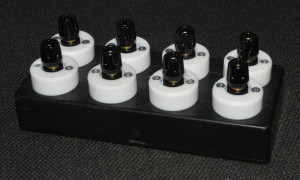To check megohm meters I made a big resistance box for a customer. http://schneiderelectronicsrepair.nl/?p=148
Because I already have standards upto 1M, I made a small version for my own use. This is something not many people need. But because I repair also isolation testers (known better as Meggers, this is not correct because Megger is a brand and they also make/made other things)
It is made from 6 Ohmite resistors from the slim mox line. 1W, 1% , 5kV and 25ppm/C. Also important is a low voltco, in this case 2ppm/V . This something that can be important. If I test a megohm meter while repairing, I do not care about the exact value. But if I have to adjust or calibrate the instrument, it can be important. Not often because most megohm meters do not have a high resolution.
I will give an example for the 1G resistor. It is a 1% resistor. That means the real value will be somewhere between 990 Mohm and 1.010 Mohm. 1% sounds low but it is 10M. If you buy a very large amount of this resistors the most will be close to 1G. This will not say you are lucky, you also can get a 990 Mohm. Megohm meters often source a voltage to measure. These can be as high as 1000V. And that is why you want to know the voltco. So if you measure the 1G resistor with 10V the voltco will be 10 x 2ppm. 20ppm is 20 parts per million., in ohms: +/- 20kohm. Not a huge number and most meters have not enough resolution. But if you source 1000V this will be 2000ppm or 2Mohm and that is well within the resolution of many Megohm meter. And then there is the tempco. 25ppm/C. The 1G 1% will be for a given temperature, most times somewhere around 25C. But if you are using it at a temperature of 35C the value will rise with 250ppm, or 250kohm. And this will be more because the resistor must dissipate power. This will not be a lot at 1G. The max voltage is 5kV, that is a wopping 5uA current and the resistor has to dissipate 0,025W. This will not give you blisters. And not only because they do not get that hot, but more because you should not touch the resistors. Also you need to keep the material of the box between the terminals clean. Dirt can cause a leakage path for the testcurrent. And that is current you want through your resistor to measure the right value. That is why I used teflon isolation. My box is small. That shows up for 1 and 5G on my standard. The big box I made for a customer has less leakage because the bigger distance between the terminals. It is always a bit difficult. Metal will be better because it shields the resistors but it has a very low resistance so the teflon is the only barrier. And if you test at 1000V you do not want the risk the cabinet is carrying 1000V.
My resistors turned out to be the following values.
10M = 9.994.106
20M= 20.213.218
100M=100.829.828
200M=202.020.202
1G= must be between 987.875.000 and 1.012.125.000
5G= must be between 4.939.375.000 and 5.060.625.000 (1%, 25ppm/C, 1,5W, 10kV and 5ppm/V)
I have not measured the 2 highest. This is not simple, and a lot of work. One day I probably will do this, but for me this is not very important. I just needed some high values to test megohm meters and isolation testers.
I made teflon isolaters on my lathe to mount the gold plated Hirschman connectors. This to minimize the leakage current. To work with these high values you must be sure to keep the resistors clean. I wear gloves while mounting the resistors. The dealer does not do that (I asked) so I had to clean them first with IPA (advise from Ohmite).
